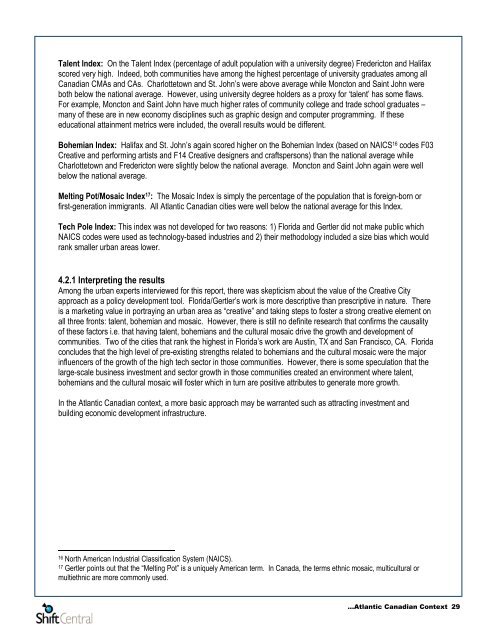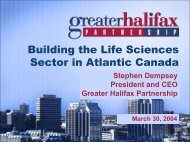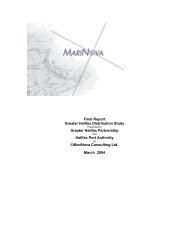Atlantic Canada's Urban Growth Agenda - Greater Halifax Partnership
Atlantic Canada's Urban Growth Agenda - Greater Halifax Partnership
Atlantic Canada's Urban Growth Agenda - Greater Halifax Partnership
You also want an ePaper? Increase the reach of your titles
YUMPU automatically turns print PDFs into web optimized ePapers that Google loves.
Talent Index: On the Talent Index (percentage of adult population with a university degree) Fredericton and <strong>Halifax</strong><br />
scored very high. Indeed, both communities have among the highest percentage of university graduates among all<br />
Canadian CMAs and CAs. Charlottetown and St. John’s were above average while Moncton and Saint John were<br />
both below the national average. However, using university degree holders as a proxy for ‘talent’ has some flaws.<br />
For example, Moncton and Saint John have much higher rates of community college and trade school graduates –<br />
many of these are in new economy disciplines such as graphic design and computer programming. If these<br />
educational attainment metrics were included, the overall results would be different.<br />
Bohemian Index: <strong>Halifax</strong> and St. John’s again scored higher on the Bohemian Index (based on NAICS 16 codes F03<br />
Creative and performing artists and F14 Creative designers and craftspersons) than the national average while<br />
Charlottetown and Fredericton were slightly below the national average. Moncton and Saint John again were well<br />
below the national average.<br />
Melting Pot/Mosaic Index 17 : The Mosaic Index is simply the percentage of the population that is foreign-born or<br />
first-generation immigrants. All <strong>Atlantic</strong> Canadian cities were well below the national average for this Index.<br />
Tech Pole Index: This index was not developed for two reasons: 1) Florida and Gertler did not make public which<br />
NAICS codes were used as technology-based industries and 2) their methodology included a size bias which would<br />
rank smaller urban areas lower.<br />
4.2.1 Interpreting the results<br />
Among the urban experts interviewed for this report, there was skepticism about the value of the Creative City<br />
approach as a policy development tool. Florida/Gertler’s work is more descriptive than prescriptive in nature. There<br />
is a marketing value in portraying an urban area as “creative” and taking steps to foster a strong creative element on<br />
all three fronts: talent, bohemian and mosaic. However, there is still no definite research that confirms the causality<br />
of these factors i.e. that having talent, bohemians and the cultural mosaic drive the growth and development of<br />
communities. Two of the cities that rank the highest in Florida’s work are Austin, TX and San Francisco, CA. Florida<br />
concludes that the high level of pre-existing strengths related to bohemians and the cultural mosaic were the major<br />
influencers of the growth of the high tech sector in those communities. However, there is some speculation that the<br />
large-scale business investment and sector growth in those communities created an environment where talent,<br />
bohemians and the cultural mosaic will foster which in turn are positive attributes to generate more growth.<br />
In the <strong>Atlantic</strong> Canadian context, a more basic approach may be warranted such as attracting investment and<br />
building economic development infrastructure.<br />
16 North American Industrial Classification System (NAICS).<br />
17 Gertler points out that the “Melting Pot” is a uniquely American term. In Canada, the terms ethnic mosaic, multicultural or<br />
multiethnic are more commonly used.<br />
…<strong>Atlantic</strong> Canadian Context 29





